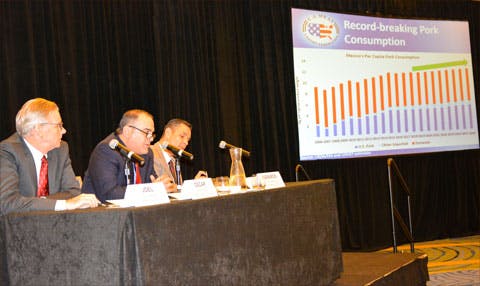USMEF Spring Conference Concludes with Insights from China and Mexico
The U.S. red meat industry must remain flexible and be prepared for whatever happens in China and Mexico – two markets that are vastly different but each of which has great potential for further growth. This was the message sent during the “China and Mexico Demand Panel,” part of Friday’s closing business session at the USMEF Spring Conference in Arlington, Virginia. Panelists were Joel Haggard, senior vice president for the Asia Pacific; Oscar Ferrara, regional director for Mexico, Central America and the Dominican Republic; and Gerardo Rodriguez, marketing director for Mexico, Central America and the Dominican Republic.

Joel Haggard, Oscar Ferrara and Gerardo Rodriguez made up the “China and Mexico Demand Panel” at the USMEF Spring Conference
With recent progress toward reopening China to U.S. beef and U.S. preparations to renegotiate NAFTA on the minds of many USMEF members, the panel was designed to address each market’s current demands for beef and pork, along with how that demand could change in the future.
Haggard cautioned that China is a bit of a puzzle. He presented forecasts by China’s Ministry of Agriculture that predict consumption of both beef and pork will continue to outpace production over the next decade. For beef, production, consumption and imports all will trend upward. Pork production and consumption will climb, but imports are expected to drop slightly.
“So what’s demand (for U.S. beef) going to be? Are we going to be able to sell just middle meats in China? I’ve been besieged by these questions since the recent announcements about China, but these are difficult questions to answer,” Haggard told the audience. “Trying to project out what pork demand in China is going to be is also difficult, and the experts’ predictions on this vary greatly.”
The Mexican market, currently a stronghold for U.S. exports, became an area of concern when the Trump administration indicated its intention to renegotiate NAFTA. Both Ferrara and Rodriguez pointed out that the U.S. red meat industry should remain proactive – even during this time of uncertainty.
“Things are changing fast, everywhere, and we shouldn’t spend all our time worrying about what may or may not happen with NAFTA,” Rodriguez told the audience, adding that it’s important that the U.S. not rest on its laurels. “Yes, when it comes to pork and beef, we have the biggest market share, but we cannot relax. It’s time to expand, not only with the products we offer in Mexico, but it’s time to expand and include more emphasis on Central America as well.”
Ferrara presented an analysis of consumer confidence in Mexico before and after the 2016 U.S. presidential election, combining those numbers with the U.S.-Mexico exchange rate. There was a huge dip when Donald Trump took office earlier this year, but both numbers have rebounded.
Mexico’s record-setting pork consumption is expected to continue its rise, Ferrara said, but the U.S. industry needs to keep working the market hard. Concerned with future price swings, Mexico has begun to look elsewhere for affordable protein sources.
“The demand is there and will be there, but Mexico is out looking for new suppliers – including European and Chilean pork, and Australian and New Zealand beef,” Ferrara said. “So it’s very important for us to remain proactive. We don’t want to wait until we see the outcome of NAFTA.”
To further grow demand for U.S. red meat, USMEF has developed a host of educational and promotional campaigns designed to engage consumers and Mexico’s foodservice and retail representatives. Rodriguez provided several examples, including USMEF’s promotional partnerships with Walmart.
“We are teaching consumers how to properly prepare and cook U.S. pork and beef so they get the best experience with the product,” he explained. “We also work with and train supermarket managers and staff to help them increase sales in their stores.”
Also at the Friday business session, the USMEF board of directors approved a resolution supporting continued funding for the USDA Market Access Program and Foreign Market Development Program. The resolution encouraged organizations that advocate for U.S. agriculture to make funding these programs a legislative priority, noting their proven track record for bolstering U.S. exports and delivering positive returns for the U.S. economy.
